| ________________
CM . . .
. Volume XVIII Number 1. . . .September 2, 2011 
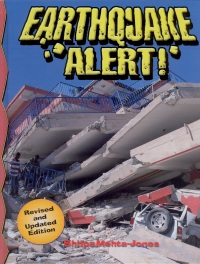 |
Earthquake Alert! (Disaster Alert!). Revised and Updated Edition.
Shilpa Mehta-Jones.
St. Catharines, ON: Crabtree, 2011.
32 pp., pbk. & hc., $10.95 (pbk.), $20.76 (RLB.).
ISBN 978-0-7787-1623-5 (pbk.), ISBN 978-0-7787-1590-0 (RLB.).
Subject Heading:
Earthquakes-Juvenile literature.
Grades 4-6 / Ages 9-11.
Review by Gail Hamilton.
*** /4
|
| |
|
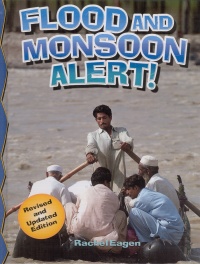 |
Flood and Monsoon Alert! (Disaster Alert!). Revised and Updated Edition.
Rachel Eagen.
St. Catharines, ON: Crabtree, 2011.
32 pp., pbk. & hc., $10.95 (pbk.), $20.76 (RLB.).
ISBN 978-0-7787-1624-2 (pbk.), ISBN 978-0-7787-1591-7 (RLB.).
Subject Headings:
Floods-Juvenile literature.
Monsoons-Juvenile literature.
Grades 4-6 / Ages 9-11.
Review by Gail Hamilton.
*** /4
|
| |
|
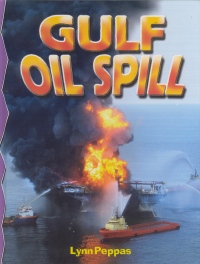 |
Gulf Oil Spill. (Disaster Alert!).
Lynn Peppas.
St. Catharines, ON: Crabtree, 2011.
32 pp., pbk. & hc., $10.95 (pbk.), $20.76 (RLB.).
ISBN 978-0-7787-1625-9 (pbk.), ISBN 978-0-7787-1592-4 (RLB.).
Subject Headings:
BP Deepwater Horizon Explosion and Oil Spill, 2010-Juvenile literature.
Oil spills-Mexico, Gulf of-Juvenile literature.
Grades 4-6 / Ages 9-11.
Review by Gail Hamilton.
*** /4
|
| |
|
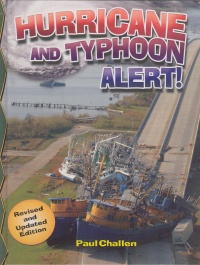 |
Hurricane and Typhoon Alert! (Disaster Alert!). Revised and Updated Edition.
Paul Challen.
St. Catharines, ON: Crabtree, 2011.
32 pp., pbk. & hc., $10.95 (pbk.), $20.76 (RLB.).
ISBN 978-0-7787-1626-6 (pbk.), ISBN 978-0-7787-1593-1 (RLB.).
Subject Headings:
Hurricanes-Juvenile literature.
Typhoons-Juvenile literature.
Grades 4-6 / Ages 9-11.
Review by Gail Hamilton.
*** /4
|
| |
|
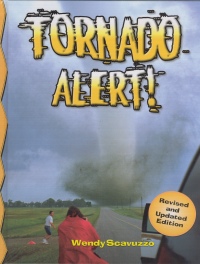 |
Tornado Alert! (Disaster Alert!). Revised and Updated Edition.
Wendy Scavuzzo.
St. Catharines, ON: Crabtree, 2011.
32 pp., pbk. & hc., $10.95 (pbk.), $20.76 (RLB.).
ISBN 978-0-7787-1627-3 (pbk.), ISBN 978-0-7787-1594-8 (RLB.).
Subject Heading:
Tornadoes-Juvenile literature.
Grades 4-6 / Ages 9-11.
Review by Gail Hamilton.
*** /4
|
| |
|
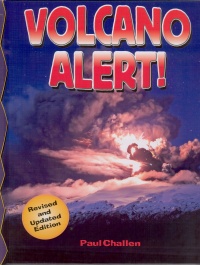 |
Volcano Alert! (Disaster Alert!). Revised and Updated Edition.
Paul Challen.
St. Catharines, ON: Crabtree, 2011.
32 pp., pbk. & hc., $10.95 (pbk.), $20.76 (RLB.).
ISBN 978-0-7787-1628-0 (pbk.), ISBN 978-0-7787-1595-5 (RLB.).
Subject Heading:
Volcanoes-Juvenile literature.
Grades 4-6 / Ages 9-11.
Review by Gail Hamilton.
*** /4
|
| |
|

excerpt:
A strong tornado can rip up almost anything, even if it appears to be firmly attached. It can uproot trees, pull heavy plumbing out of the ground, and tear up roads, fences, railroad ties, and telephone poles. The stronger the tornado, the heavier the things it can carry. In 1931, a tornado caught the Great Northern Railway's express train, The Empire Builder, and toppled five of the 70-ton (64-tonne) coaches off the tracks. It picked up one of the coaches, which was carrying 117 passengers, and hurled it into a ditch 80 feet (24 meters) away. One passenger was killed and 57 others were injured. (From Tornado Alert!)
With the exception of Gulf Oil Spill, which is the newest addition to this series, these titles are the newly revised and updated editions of the "Disaster Alert!" series and include information about recent natural disasters, such as the magnitude 7.3 earthquake in Haiti in January, 2010, and the volcanic eruption in Iceland in March of that same year.
The titles in this series offer readers abundant information coupled with excellent maps, diagrams and colour photographs. A few of the covers have changed as well, some examples being the covers of Earthquake Alert! and Volcano Alert!, both of which depict recent disasters. Averaging 12 chapters each, the books are similar in format and include such topics as the definition of the featured disaster, the science behind this natural phenomenon, a safety plan, examples of the world's worst disasters, the effects and the aftermath of the disaster, cleanup efforts, and a section entitled "Recipe for Disaster" which gives instructions for a scientific experiment related to the topic. Much of this information is a repeat of the original series. The text is easy for students to comprehend. Where there are more difficult concepts presented, diagrams accompany the text. Most of the diagrams are fairly easy to understand with the one exception, perhaps, being the tornado formation diagrams. Colourful backgrounds, an attractive layout, abundant, excellent photographs, all suitably labelled, serve to sustain the reader's interest. A table of contents, a brief glossary, an index and a couple of related websites for further study are also provided.
The changes in Earthquake Alert! reflect the recent disasters in Chile, Haiti, Turkey, Mexico and China in 2010. In this book, the author discusses the causes of earthquakes, types of faults and seismic waves, boundaries which affect the movement of tectonic plates, the work of seismologists, and the Richter Scale, which rates the severity of earthquakes. The damage from an earthquake's aftereffects, which includes tsunamis, liquefaction (soil turning into quicksand), landslides, mudslides, avalanches and fires, is also featured along with information about new building codes and techniques which ensure that structures, such as buildings and bridges, can withstand an earthquake's destructive forces. Instructions are provided for an experiment designed to show how plate tectonics and convection currents work.
More human lives have been lost to floods in the United States than to any other natural disaster. In Flood and Monsoon Alert!, readers will learn about the causes of floods, how a monsoon is formed, and the difference between summer and winter monsoons. Featured among the worst floods are the 2010 floods in Tennessee, Kentucky and Mississippi, and in Pakistan where 20 million people were affected and 1600 people were killed. It is interesting to note that the 1952 Red River flood in Winnipeg is mentioned. Other topics include flood and monsoon forecasting, preparing for a flood, and several ways to protect communities from future floods. Readers can make a simple barometer that will help them to understand air pressure and its effect on weather.
One of the largest marine oil spills in history, the Gulf Oil Spill, began on April 20, 2010, as the result of a disastrous blowout which killed 11 workers and injured 17 on the Deepwater Horizon oil rig. The rig burned for almost two days before sinking to the bottom of the ocean. In Gulf Oil Spill, there is information about how crude oil is formed, parts of the Deepwater Horizon rig and how they worked, causes of the blowout and the methods used in a valiant attempt to stop the leakage of oil into the ocean. Perhaps one of the most interesting chapters explains the many safety rules and regulations that were bypassed in the workers' haste to get their work done because delays on a large rig can cost half a million dollars per day. Other topics include cleanup efforts and the effects of oil spills, not only on marine life, but also on humans in terms of potential health risks and lost livelihoods. Of all the titles in this series, this one is, perhaps, suited to a slightly older readership.
The anatomy of a hurricane, its formation and its four stages, from tropical disturbance to a full-blown hurricane, and the five-category Saffir-Simpson Scale for rating the strength of these deadly storms are just a few of the topics covered in Hurricane and Typhoon Alert!. This title has been revised in light of 2008's devastating Cyclone Nargis in Burma and the many hurricanes in the United States, specifically hurricanes Fay, Gustav and Ike. Readers will learn how hurricanes are named as well as the problems inherent in a hurricane's aftermath and the cleanup and relief efforts involved. The experiment will replicate the eye of a hurricane in a bowl.
Tornado Alert! contains information about the conditions necessary for tornado formation as well as the differences between waterspouts, landspouts and gustnadoes, the structures and various radar systems designed to measure and photograph tornadoes and supercells, and the Fujita Scale, a tornado classification system. Other topics include storm chasers, the difference between a tornado watch and a warning, and a number of different devices and systems, some successful and others not, that have been used to photograph, track and analyze tornadoes. Of all the titles in the series, this one is the most focussed on the United States, perhaps due to Tornado Alley's being there. The experiment, which requires a glass jar, water and some beads or sparkles, demonstrates the rotating action of a tornado.
Volcano Alert! features the five different types of volcanoes - stratovolcano, cinder cone, lavadome, shield and caldera - and how they are formed. Also discussed are various kinds of lava, volcano forecasting, and the ways in which volcanologists categorize volcanoes and eruptions, one example being the Volcano Explosivity Index (VEI). Of particular interest will be eruption behaviour patterns. For instance, in Hawaii, the volcanoes tend to erupt along fissures or central vents, while Vesuvean volcanoes spew ash and gases and rain down miles away from the eruption site. Still others display a burst of lava with rocks and bombs or emit glowing clouds of ash, gas and dust while lava runs down the sides. There is also information about a unique type of glass-like lava called "Pele's Hair" (named after the Hawaiian goddess of Fire) because it looks like thin strands of hair, and a diagram which shows how an underwater volcano eventually reaches the ocean's surface and forms an island capable of sustaining vegetation. Famous volcanoes and their dramatic eruptions are also featured, the most recent being the one in Iceland which erupted from March to October, 2010. Following the instructions at the back of the book, readers will be able to make a volcano out of plaster of Paris.
Although these titles are definitely worthy of purchase, schools and libraries that have volumes from the original series need not replace them. The updated information and the photos of recent natural disasters are wonderful to have, but their inclusion in the books does not change the books significantly. Gulf Oil Spill, however, being the newest addition to the series, is a must-have.
Recommended.
Gail Hamilton is Library Learning Resources Consultant at the Instructional Resources Unit, Manitoba Department of Education in Winnipeg, MB.

To comment
on this title or this review, send mail to cm@umanitoba.ca.
Copyright © the Manitoba Library Association. Reproduction for personal
use is permitted only if this copyright notice is maintained. Any
other reproduction is prohibited without permission.
NEXT REVIEW |
TABLE OF CONTENTS FOR THIS ISSUE
- September 2, 2011May 20, 2011.
AUTHORS |
TITLES |
MEDIA REVIEWS |
PROFILES |
BACK ISSUES |
SEARCH |
CMARCHIVE |
HOME |





